Attached files
| file | filename |
|---|---|
| 8-K - FORM 8-K - PHH CORP | y84866e8vk.htm |
Exhibit 99.1
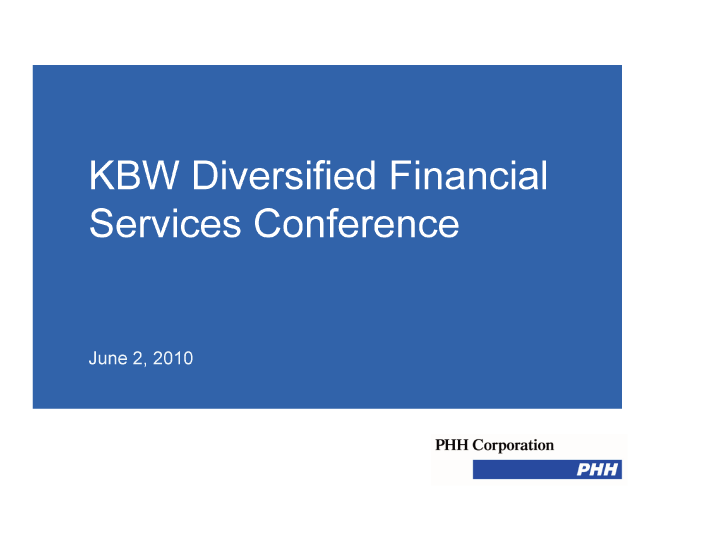
| Exhibit 99.1 KBW Diversified Financial Services Conference June 2, 2010 |
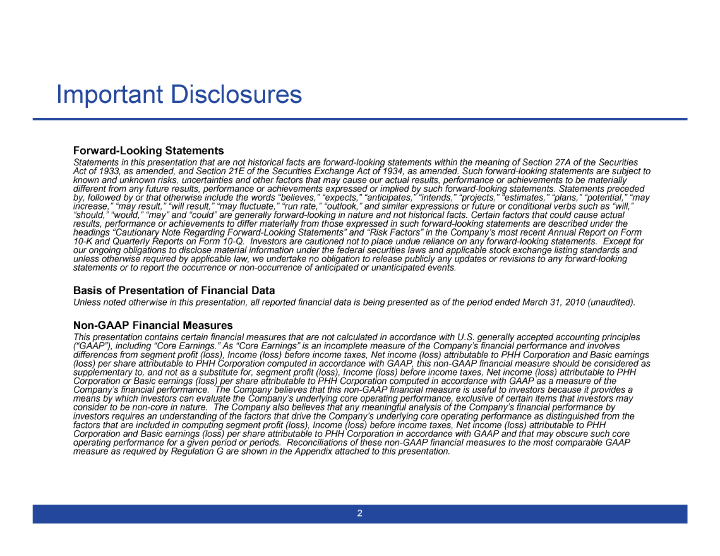
| Important Disclosures Forward-Looking Statements Statements in this presentation that are not historical facts are forward-looking statements within the meaning of Section 27A of the Securities Act of 1933, as amended, and Section 21E of the Securities Exchange Act of 1934, as amended. Such forward-looking statements are subject to known and unknown risks, uncertainties and other factors that may cause our actual results, performance or achievements to be materially different from any future results, performance or achievements expressed or implied by such forward-looking statements. Statements preceded by, followed by or that otherwise include the words “believes,” “expects,” “anticipates,” “intends,” “projects,” “estimates,” “plans,” “potential,” “may increase,” “may result,” “will result,” “may fluctuate,” “run rate,” “outlook,” and similar expressions or future or conditional verbs such as “will,” “should,” “would,” “may” and “could” are generally forward-looking in nature and not historical facts. Certain factors that could cause actual results, performance or achievements to differ materially from those expressed in such forward-looking statements are described under the headings “Cautionary Note Regarding Forward-Looking Statements” and “Risk Factors” in the Company’s most recent Annual Report on Form 10-K and Quarterly Reports on Form 10-Q. Investors are cautioned not to place undue reliance on any forward-looking statements. Except for our ongoing obligations to disclose material information under the federal securities laws and applicable stock exchange listing standards and unless otherwise required by applicable law, we undertake no obligation to release publicly any updates or revisions to any forward-looking statements or to report the occurrence or non-occurrence of anticipated or unanticipated events. Basis of Presentation of Financial Data Unless noted otherwise in this presentation, all reported financial data is being presented as of the period ended March 31, 2010 (unaudited). Non-GAAP Financial Measures This presentation contains certain financial measures that are not calculated in accordance with U.S. generally accepted accounting principles (“GAAP”), including “Core Earnings.” As “Core Earnings” is an incomplete measure of the Company’s financial performance and involves differences from segment profit (loss), Income (loss) before income taxes, Net income (loss) attributable to PHH Corporation and Basic earnings (loss) per share attributable to PHH Corporation computed in accordance with GAAP, this non-GAAP financial measure should be considered as supplementary to, and not as a substitute for, segment profit (loss), Income (loss) before income taxes, Net income (loss) attributable to PHH Corporation or Basic earnings (loss) per share attributable to PHH Corporation computed in accordance with GAAP as a measure of the Company’s financial performance. The Company believes that this non-GAAP financial measure is useful to investors because it provides a means by which investors can evaluate the Company’s underlying core operating performance, exclusive of certain items that investors may consider to be non-core in nature. The Company also believes that any meaningful analysis of the Company’s financial performance by investors requires an understanding of the factors that drive the Company’s underlying core operating performance as distinguished from the factors that are included in computing segment profit (loss), Income (loss) before income taxes, Net income (loss) attributable to PHH Corporation and Basic earnings (loss) per share attributable to PHH Corporation in accordance with GAAP and that may obscure such core operating performance for a given period or periods. Reconciliations of these non-GAAP financial measures to the most comparable GAAP measure as required by Regulation G are shown in the Appendix attached to this presentation. 2 |
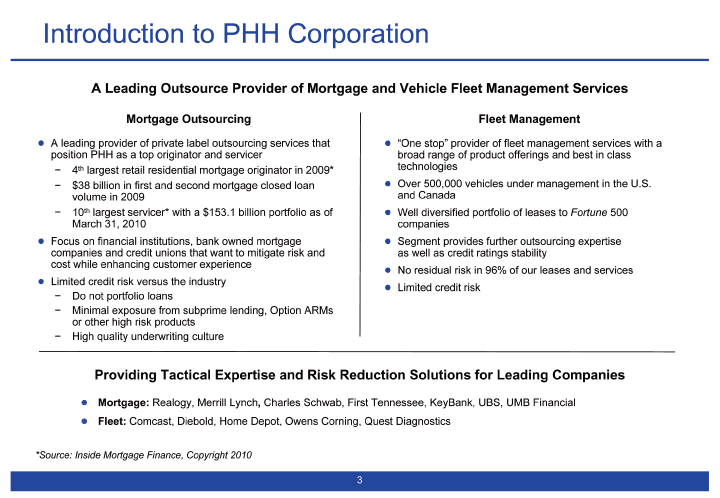
| Introduction to PHH Corporation A Leading Outsource Provider of Mortgage and Vehicle Fleet Management Services Mortgage Outsourcing A leading provider of private label outsourcing services that position PHH as a top originator and servicer 4th largest retail residential mortgage originator in 2009* $38 billion in first and second mortgage closed loan volume in 2009 10th largest servicer* with a $153.1 billion portfolio as of March 31, 2010 Focus on financial institutions, bank owned mortgage companies and credit unions that want to mitigate risk and cost while enhancing customer experience Limited credit risk versus the industry Do not portfolio loans Minimal exposure from subprime lending, Option ARMs or other high risk products High quality underwriting culture Fleet Management “One stop” provider of fleet management services with a broad range of product offerings and best in class technologies Over 500,000 vehicles under management in the U.S. and Canada Well diversified portfolio of leases to Fortune 500 companies Segment provides further outsourcing expertise as well as credit ratings stability No residual risk in 96% of our leases and services Limited credit risk Providing Tactical Expertise and Risk Reduction Solutions for Leading Companies Mortgage: Realogy, Merrill Lynch, Charles Schwab, First Tennessee, KeyBank, UBS, UMB Financial Fleet: Comcast, Diebold, Home Depot, Owens Corning, Quest Diagnostics *Source: Inside Mortgage Finance, Copyright 2010 |
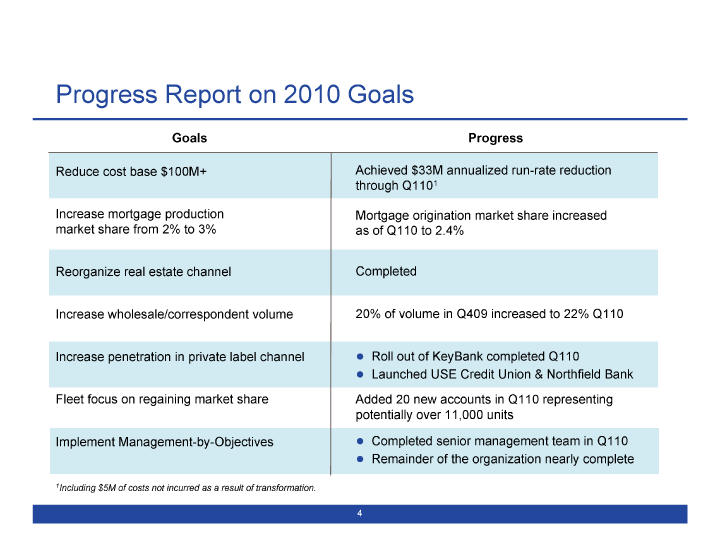
| Progress Report on 2010 Goals Goals Progress Reduce cost base $100M+ Achieved $33M annualized run-rate reduction through Q1101 Increase mortgage production Mortgage origination market share increased market share from 2% to 3% as of Q110 to 2.4% Reorganize real estate channel Completed Increase wholesale/correspondent volume 20% of volume in Q409 increased to 22% Q110 Increase penetration in private label channel ?Roll out of KeyBank completed Q110 ?Launched USE Credit Union & Northfield Bank Fleet focus on regaining market share Added 20 new accounts in Q110 representing potentially over 11,000 units Implement Management-by-Objectives ?Completed senior management team in Q110 ? Remainder of the organization nearly complete 1Including $5M of costs not incurred as a result of transformation. 4 |
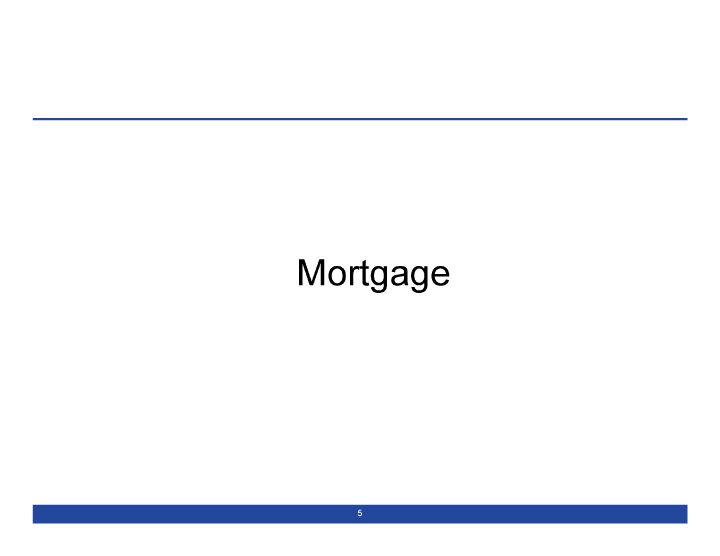
| Mortgage 5 |
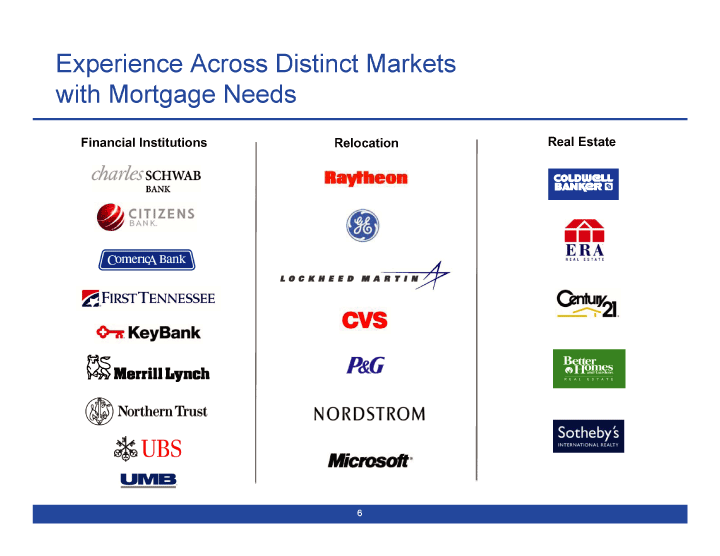
| Experience Across Distinct Markets with Mortgage Needs Financial Institutions Relocation Real Estate 6 |
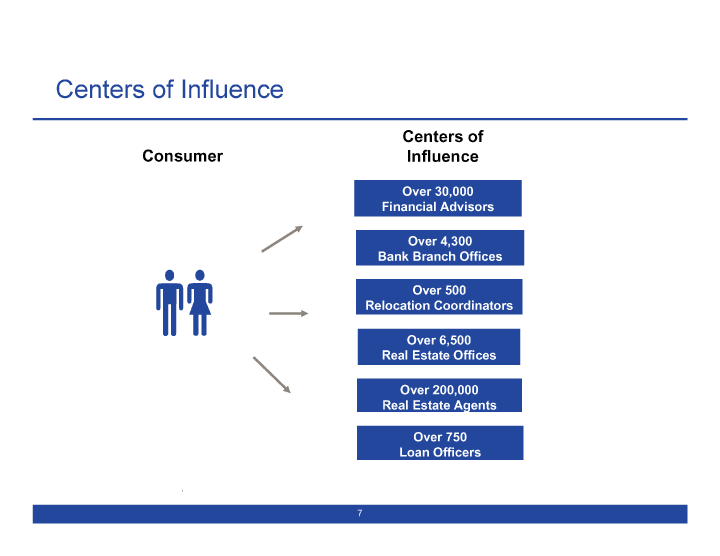
| Centers of Influence Centers of Consumer Influence Over 30,000 Financial Advisors Over 4,300 Bank Branch Offices Over 500 Relocation Coordinators Over 6,500 Real Estate Offices Over 200,000 Real Estate Agents Over 750 Loan Officers . 7 |
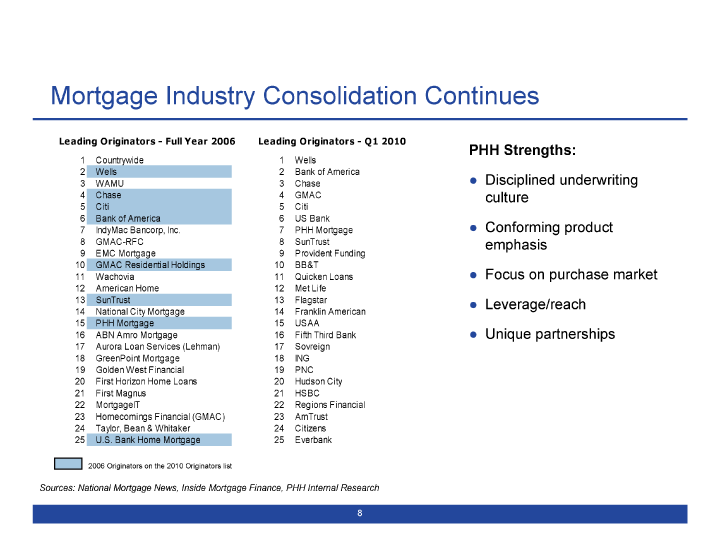
| Mortgage Industry Consolidation Continues Leading Originators — Full Year 2006 Leading Originators — Q1 2010 PHH Strengths: 1 Countrywide 1 Wells 2 Wells 2 Bank of America 3 WAMU 3 Chase ?Disciplined underwriting 4 Chase 4 GMAC culture 5 Citi 5 Citi 6 Bank of America 6 US Bank 7 IndyMac Bancorp, Inc. 7 PHH Mortgage ?Conforming product 8 GMAC-RFC 8 SunTrust emphasis 9 EMC Mortgage 9 Provident Funding 10 GMAC Residential Holdings 10 BB&T 11 Wachovia 11 Quicken Loans ?Focus on purchase market 12 American Home 12 Met Life 13 SunTrust 13 Flagstar ?Leverage/reach 14 National City Mortgage 14 Franklin American 15 PHH Mortgage 15 USAA 16 ABN Amro Mortgage 16 Fifth Third Bank ?Unique partnerships 17 Aurora Loan Services (Lehman) 17 Sovreign 18 GreenPoint Mortgage 18 ING 19 Golden West Financial 19 PNC 20 First Horizon Home Loans 20 Hudson City 21 First Magnus 21 HSBC 22 MortgageIT 22 Regions Financial 23 Homecomings Financial (GMAC) 23 AmTrust 24 Taylor, Bean & Whitaker 24 Citizens 25 U.S. Bank Home Mortgage 25 Everbank 2006 Originators on the 2010 Originators list Sources: National Mortgage News, Inside Mortgage Finance, PHH Internal Research 8 |
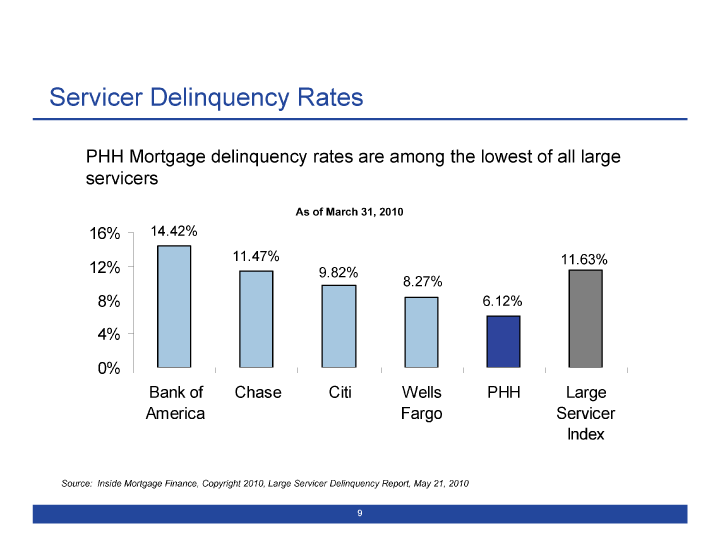
| Servicer Delinquency Rates PHH Mortgage delinquency rates are among the lowest of all large servicers As of March 31, 2010 16% 14.42% 11.47% 11.63% 12% 9.82% 8.27% 8% 6.12% 4% 0% Bank of Chase Citi Wells PHH Large America Fargo Servicer Index Source: Inside Mortgage Finance, Copyright 2010, Large Servicer Delinquency Report, May 21, 2010 9 |
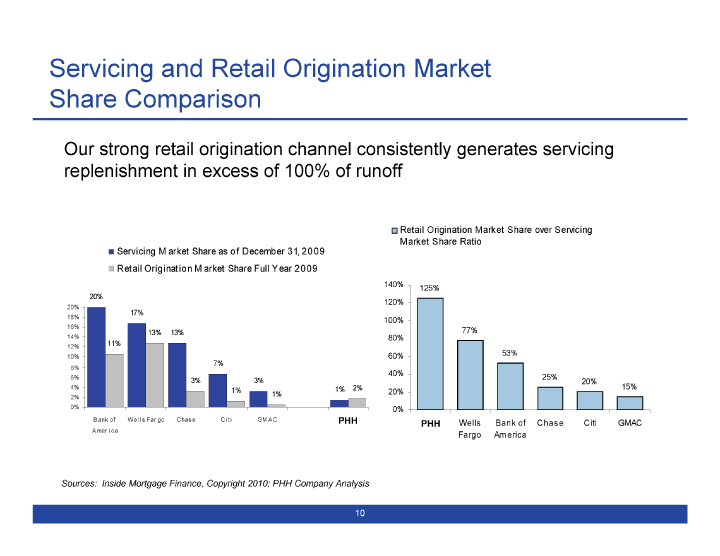
| Servicing and Retail Origination Market Share Comparison Our strong retail origination channel consistently generates servicing replenishment in excess of 100% of runoff Retail Origination Market Share over Servicing Market Share Ratio Servicing M arket Share as of December 31, 2009 Retail Origination M arket Share Full Year 2009 140% 125% 20% 120% 20% 17% 18% 100% 16% 77% 13% 13% 14% 80% 12% 11% 10% 60% 53% 7% 8% 40% 6% 3% 3% 25% 20% 4% 1% 2% 15% 1% 20% 2% 1% 0% 0% B ank of Wel l s Far go Chas e Ci t i GM A C PHH PHH Wells Bank of Chase Citi GMAC A mer i c a Fargo Am erica Sources: Inside Mortgage Finance, Copyright 2010; PHH Company Analysis 10 |
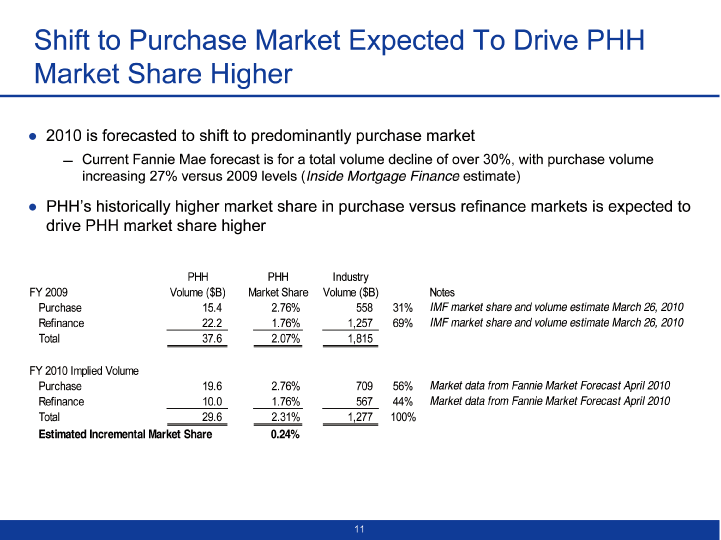
| Shift to Purchase Market Expected To Drive PHH Market Share Higher 2010 is forecasted to shift to predominantly purchase market Current Fannie Mae forecast is for a total volume decline of over 30%, with purchase volume increasing 27% versus 2009 levels (Inside Mortgage Finance estimate) PHH’s historically higher market share in purchase versus refinance markets is expected to drive PHH market share higher PHH PHH Industry FY 2009 Volume ($B) Market Share Volume ($B) Notes Purchase 15.4 2.76% 558 31% IMF market share and volume estimate March 26, 2010 Refinance 22.2 1.76% 1,257 69% IMF market share and volume estimate March 26, 2010 Total 37.6 2.07% 1,815 FY 2010 Implied Volume Purchase 19.6 2.76% 709 56% Market data from Fannie Market Forecast April 2010 Refinance 10.0 1.76% 567 44% Market data from Fannie Market Forecast April 2010 Total 29.6 2.31% 1,277 100% Estimated Incremental Market Share 0.24% |
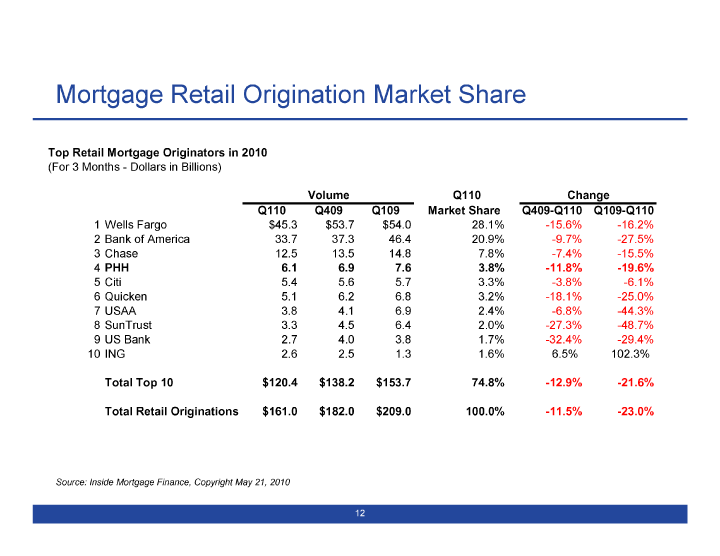
| Mortgage Retail Origination Market Share Top Retail Mortgage Originators in 2010 (For 3 Months - Dollars in Billions) Volume Q110 Change Q110 Q409 Q109 Market Share Q409-Q110 Q109-Q110 1 Wells Fargo $45.3 $53.7 $54.0 28.1% -15.6% -16.2% 2 Bank of America 33.7 37.3 46.4 20.9% -9.7% -27.5% 3 Chase 12.5 13.5 14.8 7.8% -7.4% -15.5% 4 PHH 6.1 6.9 7.6 3.8% -11.8% -19.6% 5 Citi 5.4 5.6 5.7 3.3% -3.8% -6.1% 6 Quicken 5.1 6.2 6.8 3.2% -18.1% -25.0% 7 USAA 3.8 4.1 6.9 2.4% -6.8% -44.3% 8 SunTrust 3.3 4.5 6.4 2.0% -27.3% -48.7% 9 US Bank 2.7 4.0 3.8 1.7% -32.4% -29.4% 10 ING 2.6 2.5 1.3 1.6% 6.5% 102.3% Total Top 10 $120.4 $138.2 $153.7 74.8% -12.9% -21.6% Total Retail Originations $161.0 $182.0 $209.0 100.0% -11.5% -23.0% Source: Inside Mortgage Finance, Copyright May 21, 2010 12 |

| Fleet Management Services 13 |
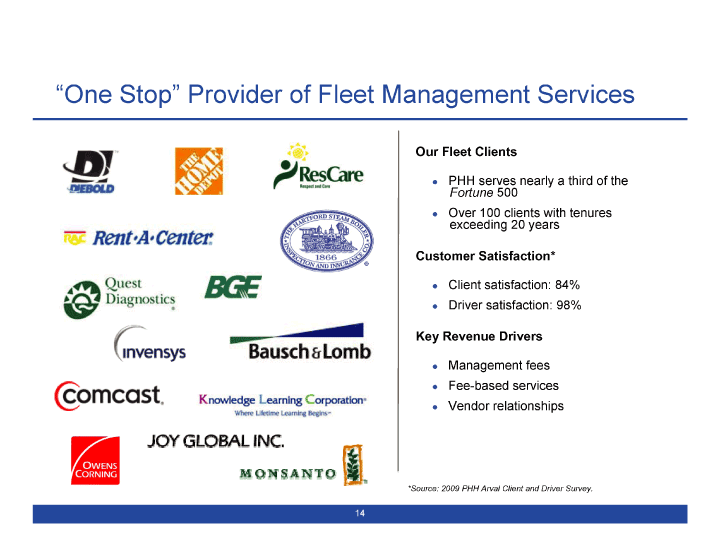
| “One Stop” Provider of Fleet Management Services Our Fleet Clients ? PHH serves nearly a third of the Fortune 500 ? Over 100 clients with tenures exceeding 20 years Customer Satisfaction* ? Client satisfaction: 84% ? Driver satisfaction: 98% Key Revenue Drivers ? Management fees ? Fee-based services ? Vendor relationships *Source: 2009 PHH Arval Client and Driver Survey. 14 |
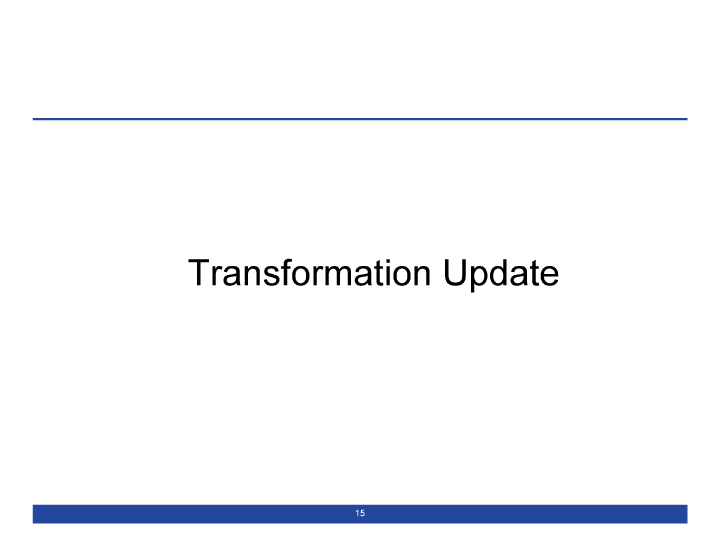
| Transformation Update 15 |

| At Least $100 Million of Potential Expense Savings Validated Through the SMART Criteria Identified and Validated Potential Savings Example Initiatives ? Increase process efficiency across back office functions and General and ~$50M transactional processes by 15%-20% using Six Sigma principles administrative ? Eliminate non-value added activities ? Leverage automation across all support processes ? Significantly reduce touch points in mortgage production to result in improved customer experience Mortgage ~$40M platform ? Leverage technology to improve efficiency in early and late stage delinquency management ? Expand process improvement program to all the major processes Fleet at Fleet ~$10M platform ? Develop technology solutions to enhance the customer experience and reduce inefficiencies (e.g., new web and phone-enabled technology simplifying driver access to services) Total identified and validated ~$100M savings 16 |
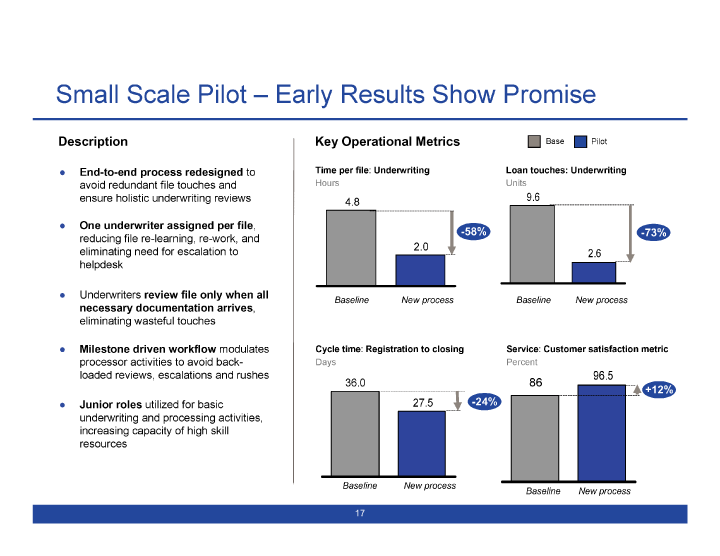
| Small Scale Pilot — Early Results Show Promise Description Key Operational Metrics Base Pilot ? End-to-end process redesigned to Time per file: Underwriting Loan touches: Underwriting avoid redundant file touches and Hours Units ensure holistic underwriting reviews 9.6 4.8 ? One underwriter assigned per file, -58% -73% reducing file re-learning, re-work, and eliminating need for escalation to 2.0 2.6 helpdesk ? Underwriters review file only when all Baseline New process Baseline New process necessary documentation arrives, eliminating wasteful touches ? Milestone driven workflow modulates Cycle time: Registration to closing Service: Customer satisfaction metric processor activities to avoid back- Days Percent loaded reviews, escalations and rushes 96.5 36.0 86 +12% ? Junior roles utilized for basic 27.5 -24% underwriting and processing activities, increasing capacity of high skill resources Baseline New process Baseline New process 17 |
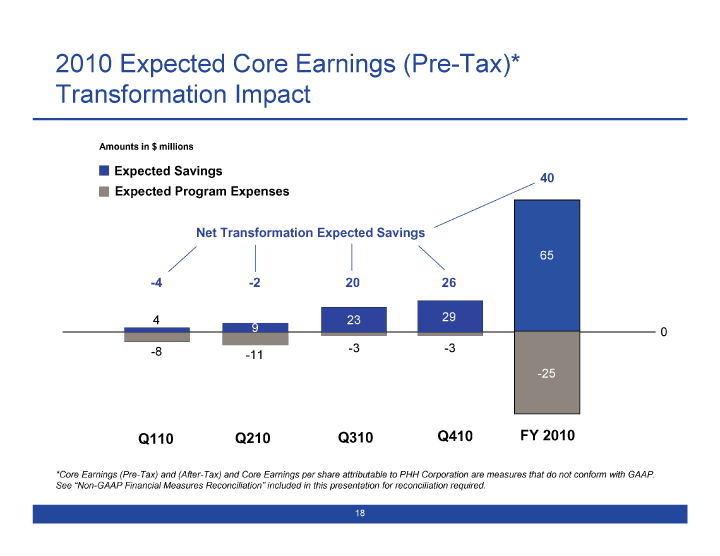
| 2010 Expected Core Earnings (Pre-Tax)* Transformation Impact Amounts in $ millions Expected Savings 40 Expected Program Expenses Net Transformation Expected Savings 65 -4 -2 20 26 4 23 29 9 0 -8 -3 -3 -11 -25 Q110 Q210 Q310 Q410 FY 2010 *Core Earnings (Pre-Tax) and (After-Tax) and Core Earnings per share attributable to PHH Corporation are measures that do not conform with GAAP. See “Non-GAAP Financial Measures Reconciliation” included in this presentation for reconciliation required. 18 |
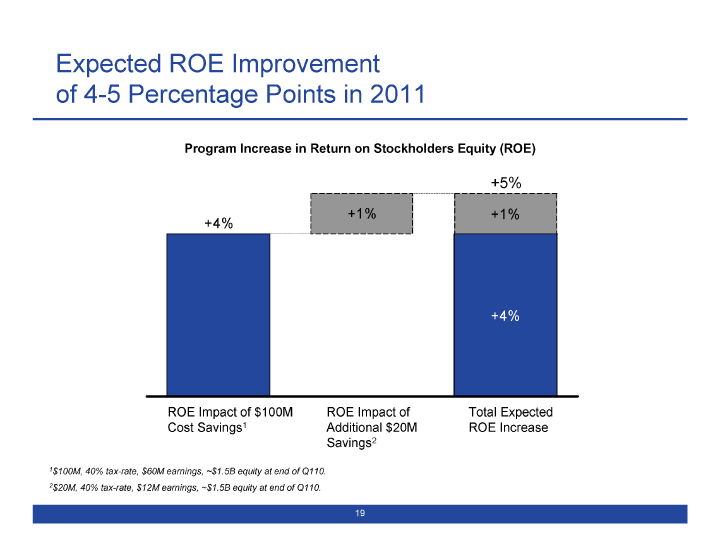
| Expected ROE Improvement of 4-5 Percentage Points in 2011 Program Increase in Return on Stockholders Equity (ROE) +5% +1% +1% +4% +4% ROE Impact of $100M ROE Impact of Total Expected Cost Savings1 Additional $20M ROE Increase Savings2 1 $100M, 40% tax-rate, $60M earnings, ~$1.5B equity at end of Q110. 2 $20M, 40% tax-rate, $12M earnings, ~$1.5B equity at end of Q110. 19 |
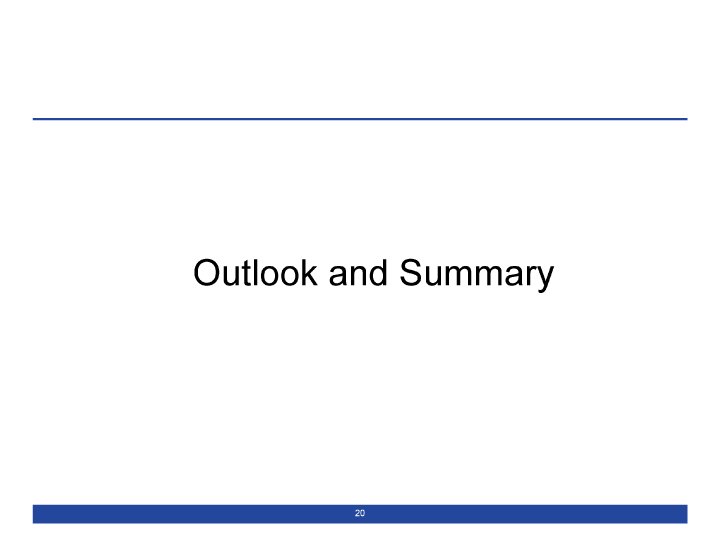
| Outlook and Summary 20 |
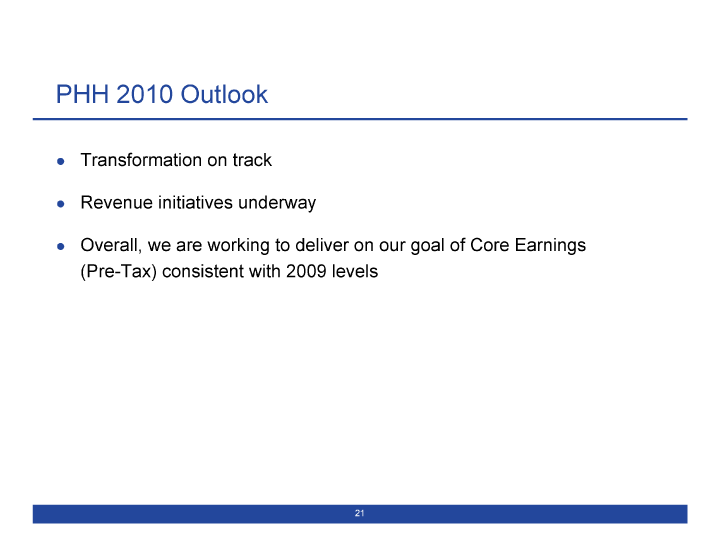
| ? Transformation on track ? Revenue initiatives underway ? Overall, we are working to deliver on our goal of Core Earnings (Pre-Tax) consistent with 2009 levels 21 |
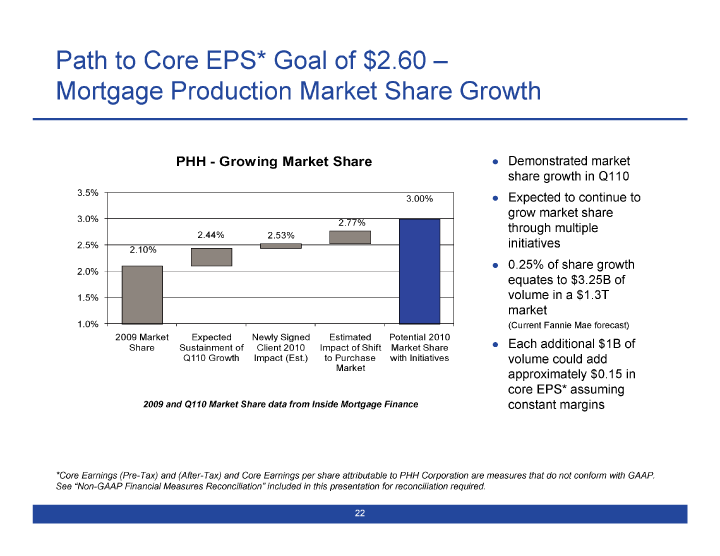
| Path to Core EPS* Goal of $2.60 -Mortgage Production Market Share Growth PHH — Growing Market Share ? Demonstrated market share growth in Q110 3.5% ? Expected to continue to 3.00% grow market share 3.0% 2.77% through multiple 2.44% 2.53% 2.5% initiatives 2.10% ? 0.25% of share growth 2.0% equates to $3.25B of 1.5% volume in a $1.3T market 1.0% (Current Fannie Mae forecast) 2009 Market Expected Newly Signed Estimated Potential 2010 Share Sustainment of Client 2010 Impact of Shift Market Share ? Each additional $1B of Q110 Growth Impact (Est.) to Purchase with Initiatives volume could add Market approximately $0.15 in core EPS* assuming 2009 and Q110 Market Share data from Inside Mortgage Finance constant margins *Core Earnings (Pre-Tax) and (After-Tax) and Core Earnings per share attributable to PHH Corporation are measures that do not conform with GAAP. See “Non-GAAP Financial Measures Reconciliation” included in this presentation for reconciliation required. 22 |
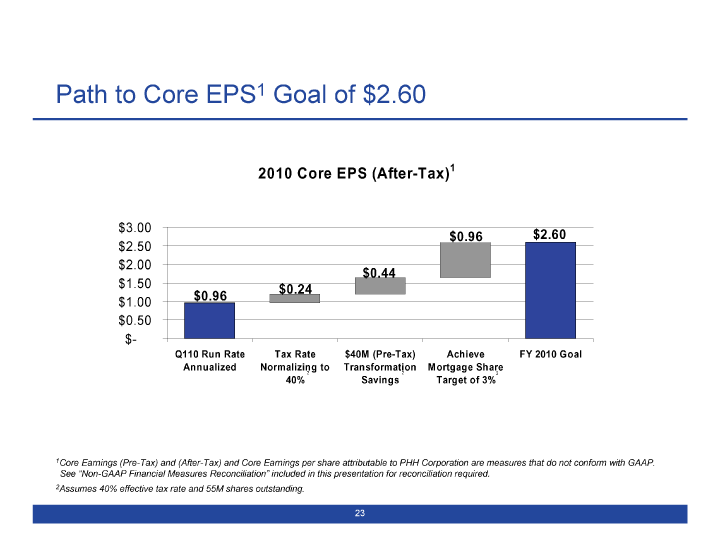
| Path to Core EPS1 Goal of $2.60 2010 Core EPS (After-Tax)1 $3.00 $0.96 $2.60 $2.50 $2.00 $0.44 $1.50 $0.24 $0.96 $1.00 $0.50 $- Q110 Run Rate Tax Rate $40M (Pre-Tax) Achieve FY 2010 Goal Annualized Normalizing to Transformation Mortgage Share 2 2 2 40% Savings Target of 3% 1Core Earnings (Pre-Tax) and (After-Tax) and Core Earnings per share attributable to PHH Corporation are measures that do not conform with GAAP. See “Non-GAAP Financial Measures Reconciliation” included in this presentation for reconciliation required. 2Assumes 40% effective tax rate and 55M shares outstanding. 23 |
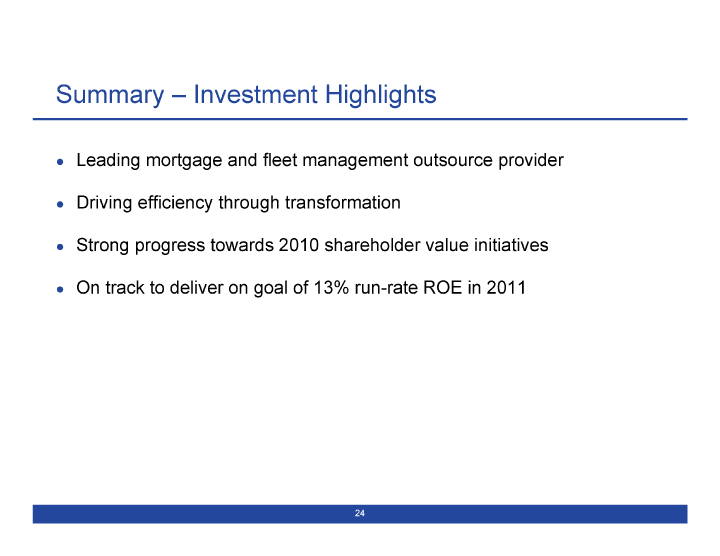
| Summary — Investment Highlights ? Leading mortgage and fleet management outsource provider ? Driving efficiency through transformation ? Strong progress towards 2010 shareholder value initiatives ? On track to deliver on goal of 13% run-rate ROE in 2011 24 |
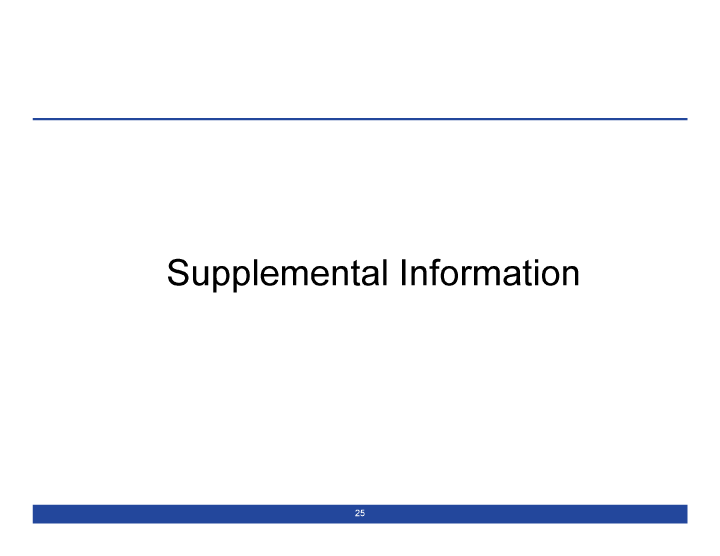
| Supplemental Information 25 |
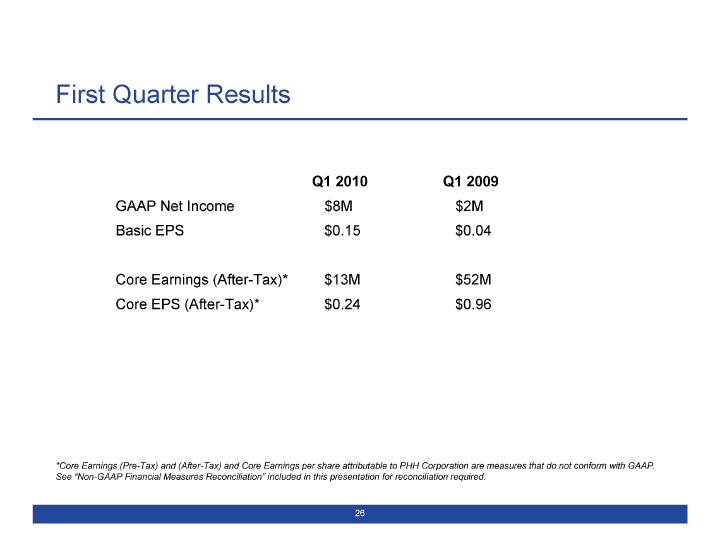
| First Quarter Results Q1 2010 Q1 2009 GAAP Net Income $8M $2M Basic EPS $0.15 $0.04 Core Earnings (After-Tax)* $13M $52M Core EPS (After-Tax)* $0.24 $0.96 *Core Earnings (Pre-Tax) and (After-Tax) and Core Earnings per share attributable to PHH Corporation are measures that do not conform with GAAP. See “Non-GAAP Financial Measures Reconciliation” included in this presentation for reconciliation required. 26 |
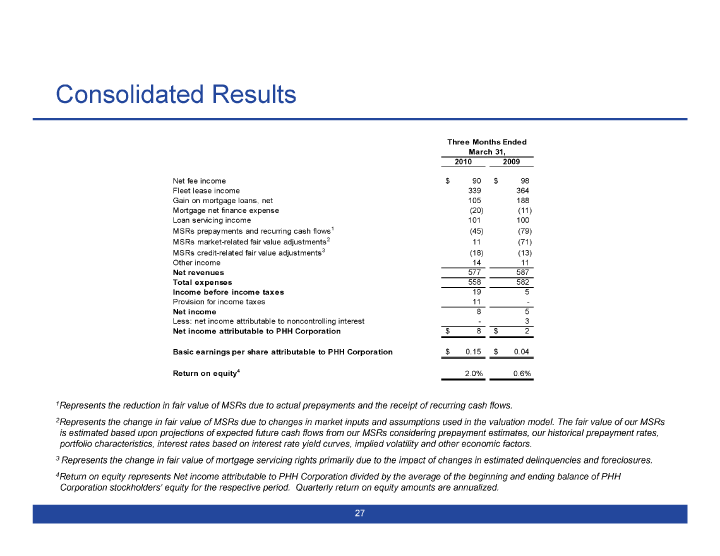
| Consolidated Results Three Months Ended March 31, 2010 2009 Net fee income $90 $98 Fleet lease income 339 364 Gain on mortgage loans, net 105 188 Mortgage net finance expense (20) (11) Loan servicing income 101 100 MSRs prepayments and recurring cash flows1 (45) (79) MSRs market-related fair value adjustments2 11 (71) MSRs credit-related fair value adjustments3 (18) (13) Other income 14 11 Net revenues 577 587 Total expenses 558 582 Income before income taxes 19 5 Provision for income taxes 11 — Net income 8 5 Less: net income attributable to noncontrolling interest — 3 Net income attributable to PHH Corporation $8 $2 Basic earnings per share attributable to PHH Corporation $0.15 $0.04 Return on equity4 2.0% 0.6% 1Represents the reduction in fair value of MSRs due to actual prepayments and the receipt of recurring cash flows. 2Represents the change in fair value of MSRs due to changes in market inputs and assumptions used in the valuation model. The fair value of our MSRs is estimated based upon projections of expected future cash flows from our MSRs considering prepayment estimates, our historical prepayment rates, portfolio characteristics, interest rates based on interest rate yield curves, implied volatility and other economic factors. 3 Represents the change in fair value of mortgage servicing rights primarily due to the impact of changes in estimated delinquencies and foreclosures. 4Return on equity represents Net income attributable to PHH Corporation divided by the average of the beginning and ending balance of PHH Corporation stockholders’ equity for the respective period. Quarterly return on equity amounts are annualized. 27 |
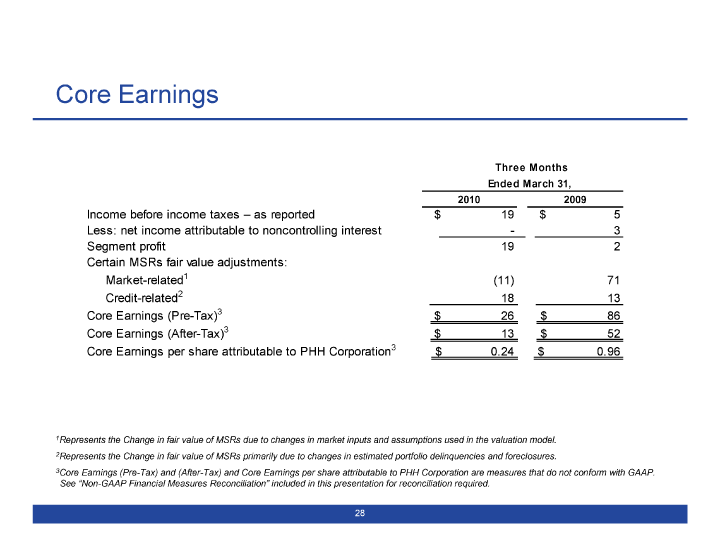
| Core Earnings Three Months Ended March 31, 2010 2009 Income before income taxes — as reported $19 $5 Less: net income attributable to noncontrolling interest — 3 Segment profit 19 2 Certain MSRs fair value adjustments: Market-related1 (11) 71 Credit-related2 18 13 Core Earnings (Pre-Tax)3 $26 $86 Core Earnings (After-Tax)3 $13 $52 Core Earnings per share attributable to PHH Corporation3 $0.24 $0.96 1Represents the Change in fair value of MSRs due to changes in market inputs and assumptions used in the valuation model. 2Represents the Change in fair value of MSRs primarily due to changes in estimated portfolio delinquencies and foreclosures. 3Core Earnings (Pre-Tax) and (After-Tax) and Core Earnings per share attributable to PHH Corporation are measures that do not conform with GAAP. See “Non-GAAP Financial Measures Reconciliation” included in this presentation for reconciliation required. 28 |
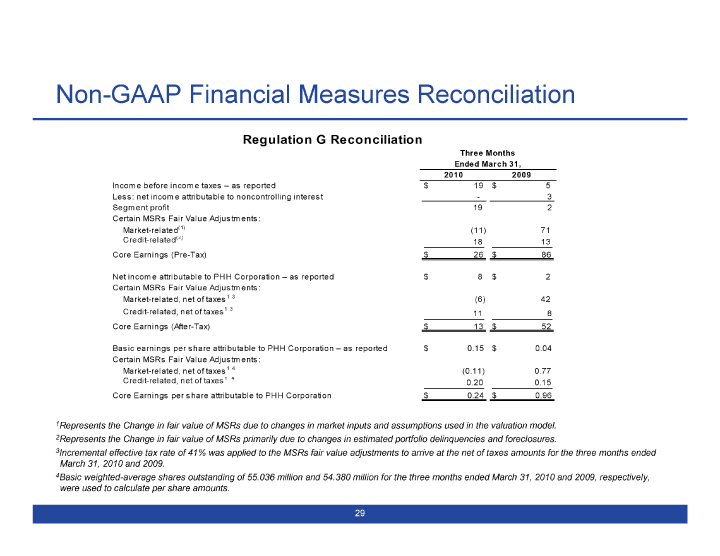
| Non-GAAP Financial Measures Reconciliation Regulation G Reconciliation Three Months Ended March 31, 2010 2009 Incom e before incom e taxes — as reported $19 $5 Less: net incom e attributable to noncontrolling interest — 3 Segm ent profit 19 2 Certain MSRs Fair Value Adjustm ents: Market-related(1) (11) 71 Credit-related(2) 18 13 Core Earnings (Pre-Tax) $26 $86 Net incom e attributable to PHH Corporation — as reported $8 $2 Certain MSRs Fair Value Adjustm ents: Market-related, net of taxes1 3 (6) 42 Credit-related, net of taxes1 3 11 8 Core Earnings (After-Tax) $13 $52 Basic earnings per share attributable to PHH Corporation — as reported $0.15 $0.04 Certain MSRs Fair Value Adjustm ents: Market-related, net of taxes1 4 (0.11) 0.77 Credit-related, net of taxes1 4 0.20 0.15 Core Earnings per share attributable to PHH Corporation $ 0.24 $0.96 1Represents the Change in fair value of MSRs due to changes in market inputs and assumptions used in the valuation model. 2Represents the Change in fair value of MSRs primarily due to changes in estimated portfolio delinquencies and foreclosures. 3Incremental effective tax rate of 41% was applied to the MSRs fair value adjustments to arrive at the net of taxes amounts for the three months ended March 31, 2010 and 2009. 4Basic weighted-average shares outstanding of 55.036 million and 54.380 million for the three months ended March 31, 2010 and 2009, respectively, were used to calculate per share amounts. 29 |
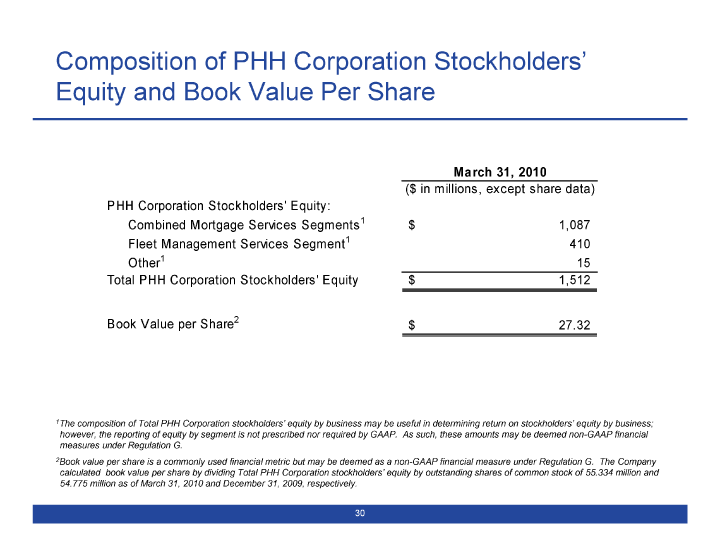
| Composition of PHH Corporation Stockholders’ Equity and Book Value Per Share March 31, 2010 ($ in millions, except share data) PHH Corporation Stockholders’ Equity: Combined Mortgage Services Segments1 $1,087 Fleet Management Services Segment1 410 Other1 15 Total PHH Corporation Stockholders’ Equity $1,512 Book Value per Share2 $27.32 1The composition of Total PHH Corporation stockholders’ equity by business may be useful in determining return on stockholders’ equity by business; however, the reporting of equity by segment is not prescribed nor required by GAAP. As such, these amounts may be deemed non-GAAP financial measures under Regulation G. 2Book value per share is a commonly used financial metric but may be deemed as a non-GAAP financial measure under Regulation G. The Company calculated book value per share by dividing Total PHH Corporation stockholders’ equity by outstanding shares of common stock of 55.334 million and 54.775 million as of March 31, 2010 and December 31, 2009, respectively. 30 |
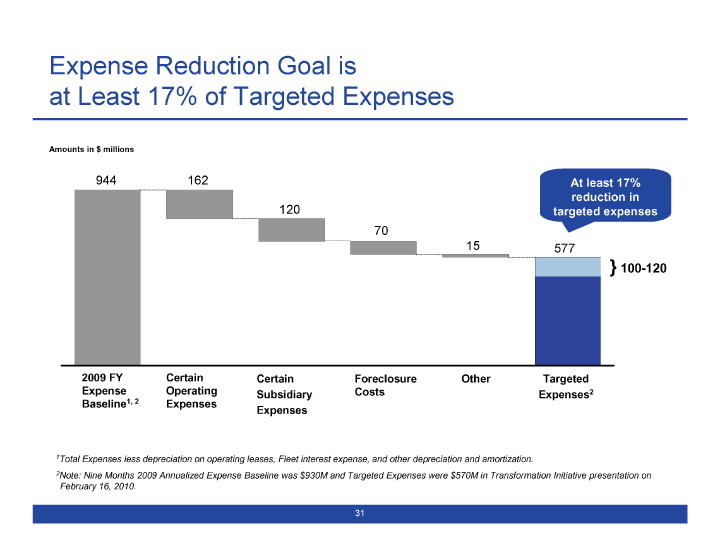
| Expense Reduction Goal is at Least 17% of Targeted Expenses Amounts in $ millions 944 162 At least 17% reduction in 120 targeted expenses 70 15 577 } 100-120 2009 FY Certain Certain Foreclosure Other Targeted Expense Operating Subsidiary Costs Expenses2 Baseline1, 2 Expenses Expenses 1Total Expenses less depreciation on operating leases, Fleet interest expense, and other depreciation and amortization. 2Note: Nine Months 2009 Annualized Expense Baseline was $930M and Targeted Expenses were $570M in Transformation Initiative presentation on February 16, 2010. 31 |
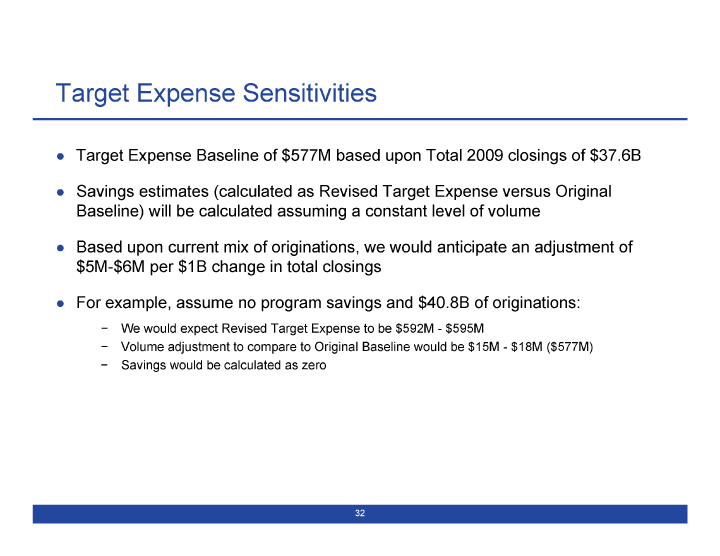
| Target Expense Sensitivities ? Target Expense Baseline of $577M based upon Total 2009 closings of $37.6B ? Savings estimates (calculated as Revised Target Expense versus Original Baseline) will be calculated assuming a constant level of volume ? Based upon current mix of originations, we would anticipate an adjustment of $5M-$6M per $1B change in total closings ? For example, assume no program savings and $40.8B of originations: We would expect Revised Target Expense to be $592M - $595M Volume adjustment to compare to Original Baseline would be $15M — $18M ($577M) Savings would be calculated as zero 32 |
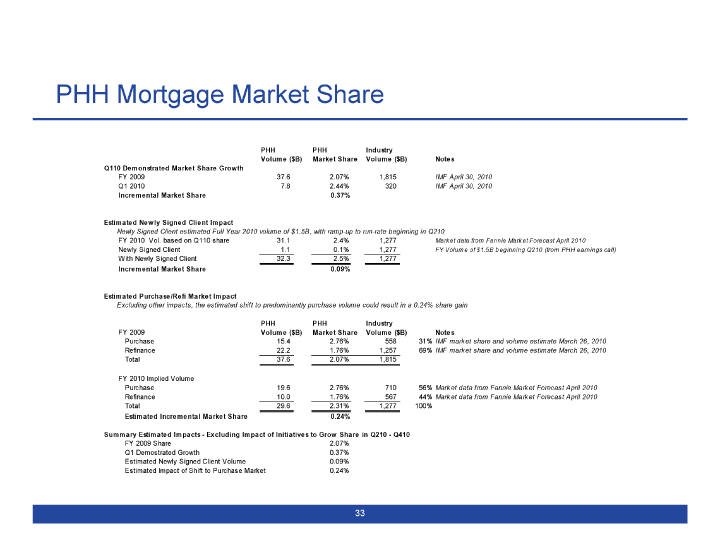
| PHH Mortgage Market Share PHH PHH Industry Volume ($B) Market Share Volume ($B) Notes Q110 Demonstrated Market Share Growth FY 2009 37.6 2.07% 1,815 IMF April 30, 2010 Q1 2010 7.8 2.44% 320 IMF April 30, 2010 Incremental Market Share 0.37% Estimated Newly Signed Client Impact Newly Signed Client estimated Full Year 2010 volume of $1.5B, with ramp-up to run-rate beginning in Q210 FY 2010 Vol. based on Q110 share 31.1 2.4% 1,277 Market data from Fannie Market Forecast April 2010 Newly Signed Client 1.1 0.1% 1,277 FY Volum e of $1.5B b eginning Q210 (from PHH earnings call) With Newly Signed Client 32.3 2.5% 1,277 Incremental Market Share 0.09% Estimated Purchase/Refi Market Impact Excluding other impacts, the estimated shift to predominantly purchase volume could result in a 0.24% share gain PHH PHH Industry FY 2009 Volume ($B) Market Share Volume ($B) Notes Purchase 15.4 2.76% 558 31% IMF mark et share and volume estimate March 26, 2010 Refinance 22.2 1.76% 1,257 69% IMF mark et share and volume estimate March 26, 2010 Total 37.6 2.07% 1,815 FY 2010 Implied Volume Purchase 19.6 2.76% 710 56% Mark et data from Fannie Mark et Forecast April 2010 Refinance 10.0 1.76% 567 44% Mark et data from Fannie Mark et Forecast April 2010 Total 29.6 2.31% 1,277 100% Estimated Incremental Market Share 0.24% Summary Estimated Impacts — Excluding Impact of Initiatives to Grow Share in Q210 — Q410 FY 2009 Share 2.07% Q1 Demostrated Growth 0.37% Estimated Newly Signed Client Volume 0.09% Estimated Impact of Shift to Purchase Market 0.24% 33 |
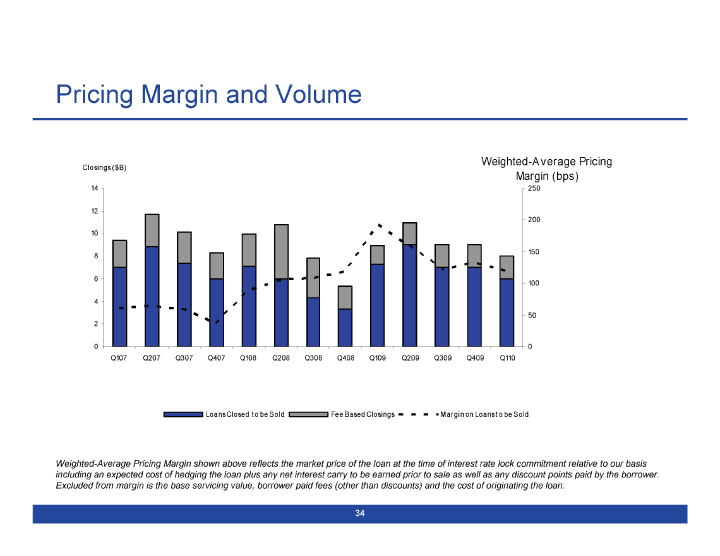
| Pricing Margin and Volume Weighted-Average Pricing Closings ($B) Margin (bps) 14 250 12 200 10 150 8 6 100 4 50 2 0 0 Q107 Q207 Q307 Q407 Q108 Q208 Q308 Q408 Q109 Q209 Q309 Q409 Q110 Loans Closed t o be Sold Fee Based Closings Margin on Loans t o be Sold Weighted-Average Pricing Margin shown above reflects the market price of the loan at the time of interest rate lock commitment relative to our basis including an expected cost of hedging the loan plus any net interest carry to be earned prior to sale as well as any discount points paid by the borrower. Excluded from margin is the base servicing value, borrower paid fees (other than discounts) and the cost of originating the loan. 34 |
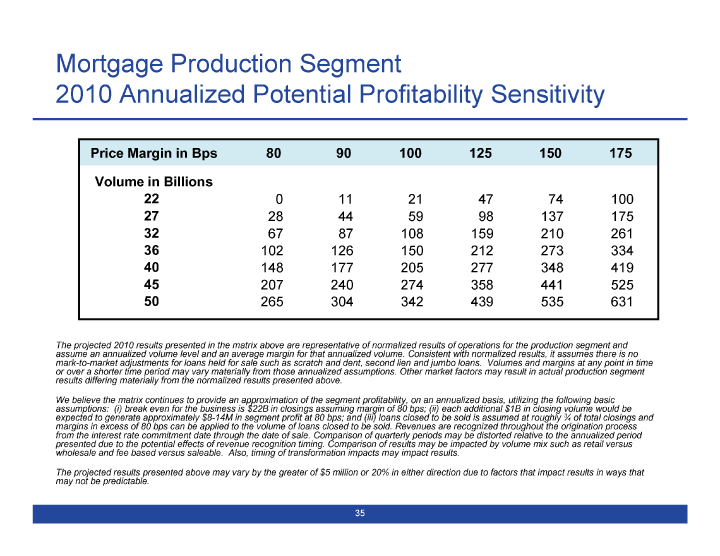
| Mortgage Production Segment 2010 Annualized Potential Profitability Sensitivity Price Margin in Bps 80 90 100 125 150 175 Volume in Billions 22 0 11 21 47 74 100 27 28 44 59 98 137 175 32 67 87 108 159 210 261 36 102 126 150 212 273 334 40 148 177 205 277 348 419 45 207 240 274 358 441 525 50 265 304 342 439 535 631 The projected 2010 results presented in the matrix above are representative of normalized results of operations for the production segment and assume an annualized volume level and an average margin for that annualized volume. Consistent with normalized results, it assumes there is no mark-to-market adjustments for loans held for sale such as scratch and dent, second lien and jumbo loans. Volumes and margins at any point in time or over a shorter time period may vary materially from those annualized assumptions. Other market factors may result in actual production segment results differing materially from the normalized results presented above. We believe the matrix continues to provide an approximation of the segment profitability, on an annualized basis, utilizing the following basic assumptions: (i) break even for the business is $22B in closings assuming margin of 80 bps; (ii) each additional $1B in closing volume would be expected to generate approximately $8-14M in segment profit at 80 bps; and (iii) loans closed to be sold is assumed at roughly 3/4 of total closings and margins in excess of 80 bps can be applied to the volume of loans closed to be sold. Revenues are recognized throughout the origination process from the interest rate commitment date through the date of sale. Comparison of quarterly periods may be distorted relative to the annualized period presented due to the potential effects of revenue recognition timing. Comparison of results may be impacted by volume mix such as retail versus wholesale and fee based versus saleable. Also, timing of transformation impacts may impact results. The projected results presented above may vary by the greater of $5 million or 20% in either direction due to factors that impact results in ways that may not be predictable. 35 |
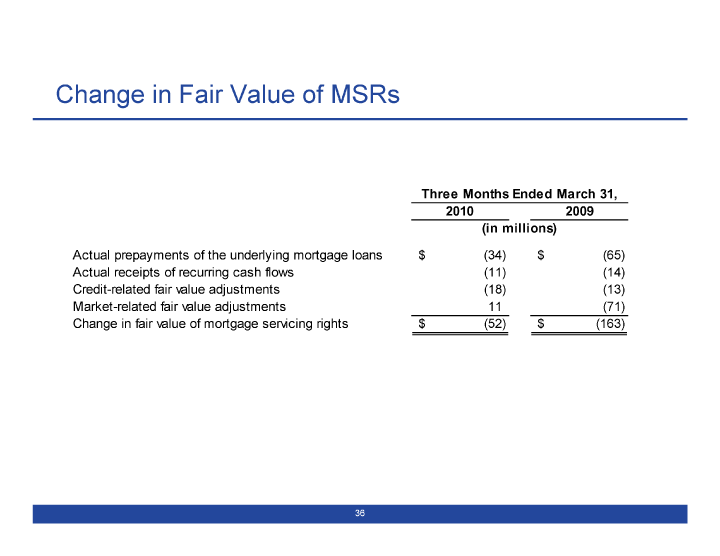
| Change in Fair Value of MSRs Three Months Ended March 31, 2010 2009 (in millions) Actual prepayments of the underlying mortgage loans $ (34) $ (65) Actual receipts of recurring cash flows (11) (14) Credit-related fair value adjustments (18) (13) Market-related fair value adjustments 11 (71) Change in fair value of mortgage servicing rights $ (52) $ (163) 36 |
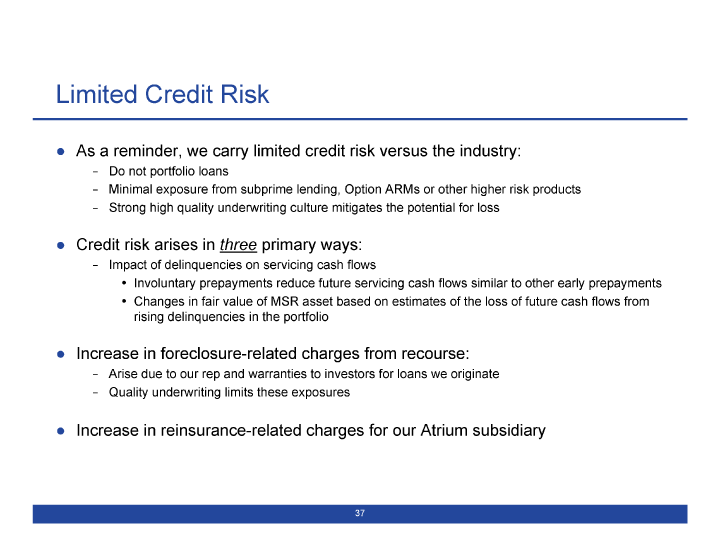
| Limited Credit Risk ? As a reminder, we carry limited credit risk versus the industry: Do not portfolio loans Minimal exposure from subprime lending, Option ARMs or other higher risk products Strong high quality underwriting culture mitigates the potential for loss ? Credit risk arises in three primary ways: Impact of delinquencies on servicing cash flows Involuntary prepayments reduce future servicing cash flows similar to other early prepayments Changes in fair value of MSR asset based on estimates of the loss of future cash flows from rising delinquencies in the portfolio ? Increase in foreclosure-related charges from recourse: Arise due to our rep and warranties to investors for loans we originate Quality underwriting limits these exposures ? Increase in reinsurance-related charges for our Atrium subsidiary 37 |
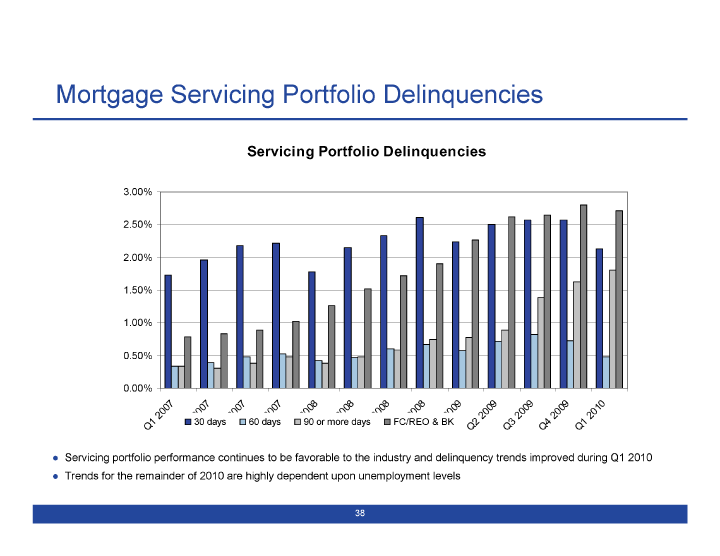
| Mortgage Servicing Portfolio Delinquencies Servicing Portfolio Delinquencies 3.00% 2.50% 2.00% 1.50% 1.00% 0.50% 0.00% 8 8 8 9 9 0 0 0 0 2007 2007 2007 2007 0 2008 2009 2009 20 2010 30 days 60 days 90 or more days FC/REO & BK Q1 Q2 Q3 Q4 Q1 ? Servicing portfolio performance continues to be favorable to the industry and delinquency trends improved during Q1 2010 ? Trends for the remainder of 2010 are highly dependent upon unemployment levels 38 |

| Impact of Delinquencies on Credit Risk Amounts in $ millions Delinquency and Unemployment Trends Delinquencies and Realized Credit Losses 12% $30 8% 0.700% 10% $25 7% 0.600% 6% 8% $20 0.500% 5% 0.400% 6% $15 4% 0.300% and BK 4% $10 3% 0.200% 2% 2% $5 1% 0.100% Total Delinquencies FC/REO and BK Realized FC Losses as a % of FC/REO 0% $0 0% 0.000% 8 9 07 007 007 08 008 09 09 010 3/31/2007 6/30/2007 9/30/2007 12/31/2007 3/31/2008 6/30/2008 9/30/2008 12/31/2008 3/31/2009 6/30/2009 9/30/2009 12/31/200903/31/2010 2 2 20 2 2 1/ 30/200 1/ 30/20 31/20 30/20 3 3 3/31/2007 6/ 9/30/ 3/31/2008 6/ 9/30/ 3/31/2009 6/30/200 9/ 2/ 12/ 12/ 1 03/31/ Total Delinquencies Realized Foreclosure Losses as % of FC/REO/BK Realized Foreclosure Losses Total Delinquencies National unemployment rate Based on PHH Corporation specific data, except historical national unemployment rate obtained from the U.S Bureau of Labor Statistics. Higher foreclosure-related charges a function of increased severity and repurchase requests Highly correlated with unemployment As unemployment improves, we would expect a reduction in our charges to more normal levels such as those seen in 2007 39 |
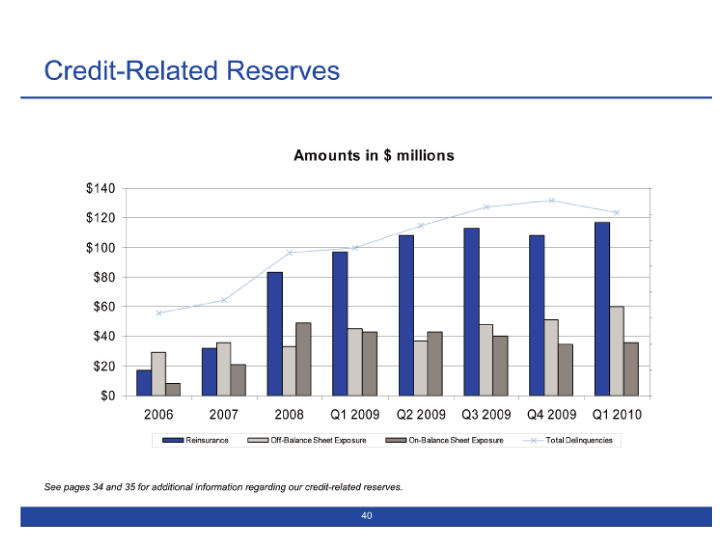
| Credit-Related Reserves Amounts in $ millions $140 $120 $100 $80 $60 $40 $20 $0 2006 2007 2008 Q1 2009 Q2 2009 Q3 2009 Q4 2009 Q1 2010 Reinsurance Off-Balance Sheet Exposure On-Balance Sheet Exposure Total Delinquencies See pages 34 and 35 for additional information regarding our credit-related reserves. 40 |
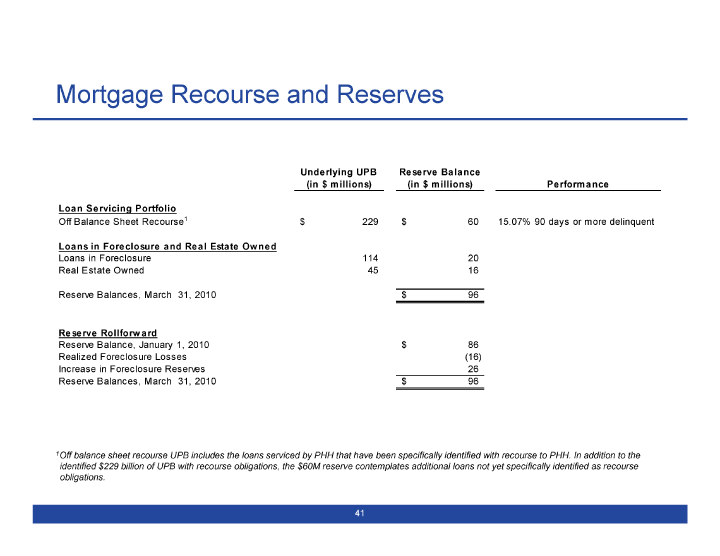
| Mortgage Recourse and Reserves Underlying UPB Reserve Balance (in $ millions) (in $ millions) Performance Loan Servicing Portfolio Off Balance Sheet Recourse1 $229 $60 15.07% 90 days or more delinquent Loans in Foreclosure and Real Estate Owned Loans in Foreclosure 114 20 Real Estate Owned 45 16 Reserve Balances, March 31, 2010 $96 Reserve Rollforward Reserve Balance, January 1, 2010 $ 86 Realized Foreclosure Losses (16) Increase in Foreclosure Reserves 26 Reserve Balances, March 31, 2010 $96 1Off balance sheet recourse UPB includes the loans serviced by PHH that have been specifically identified with recourse to PHH. In addition to the identified $229 billion of UPB with recourse obligations, the $60M reserve contemplates additional loans not yet specifically identified as recourse obligations. |
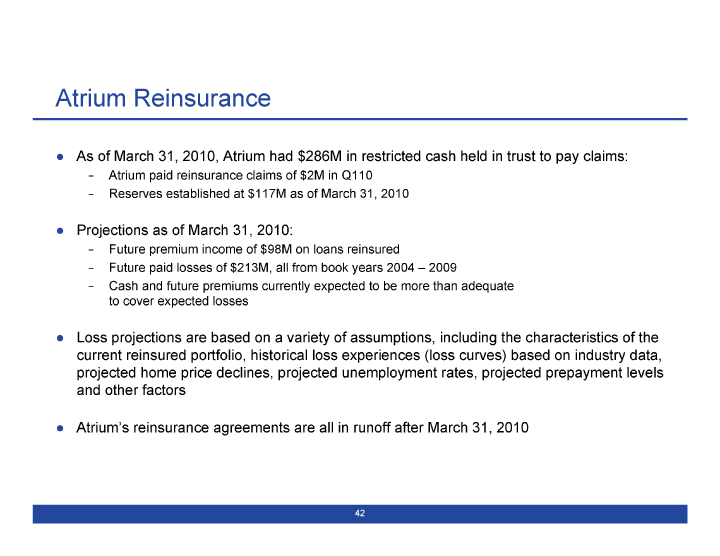
| Atrium Reinsurance ? As of March 31, 2010, Atrium had $286M in restricted cash held in trust to pay claims: Atrium paid reinsurance claims of $2M in Q110 Reserves established at $117M as of March 31, 2010 ? Projections as of March 31, 2010: Future premium income of $98M on loans reinsured Future paid losses of $213M, all from book years 2004 — 2009 Cash and future premiums currently expected to be more than adequate to cover expected losses ? Loss projections are based on a variety of assumptions, including the characteristics of the current reinsured portfolio, historical loss experiences (loss curves) based on industry data, projected home price declines, projected unemployment rates, projected prepayment levels and other factors ? Atrium’s reinsurance agreements are all in runoff after March 31, 2010 42 |
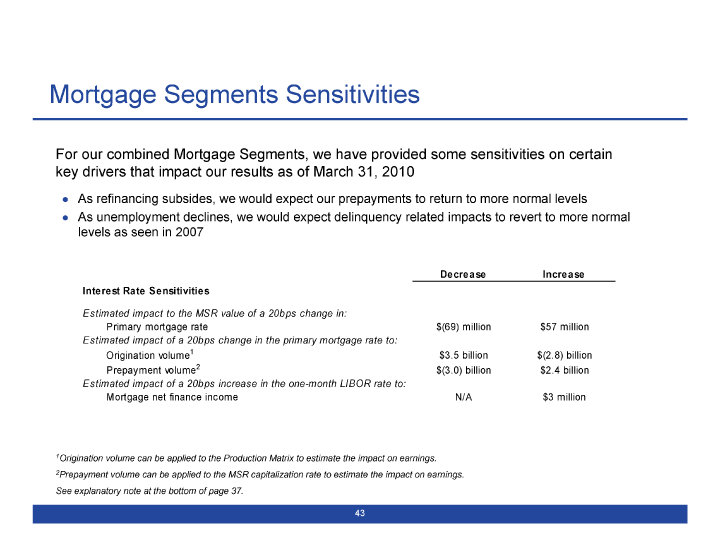
| Mortgage Segments Sensitivities For our combined Mortgage Segments, we have provided some sensitivities on certain key drivers that impact our results as of March 31, 2010 ? As refinancing subsides, we would expect our prepayments to return to more normal levels ? As unemployment declines, we would expect delinquency related impacts to revert to more normal levels as seen in 2007 Decrease Increase Interest Rate Sensitivities Estimated impact to the MSR value of a 20bps change in: Primary mortgage rate $(69) million $57 million Estimated impact of a 20bps change in the primary mortgage rate to: Origination volume1 $3.5 billion $(2.8) billion Prepayment volume2 $(3.0) billion $2.4 billion Estimated impact of a 20bps increase in the one-month LIBOR rate to: Mortgage net finance income N/A $3 million 1Origination volume can be applied to the Production Matrix to estimate the impact on earnings. 2Prepayment volume can be applied to the MSR capitalization rate to estimate the impact on earnings. See explanatory note at the bottom of page 37. 43 |
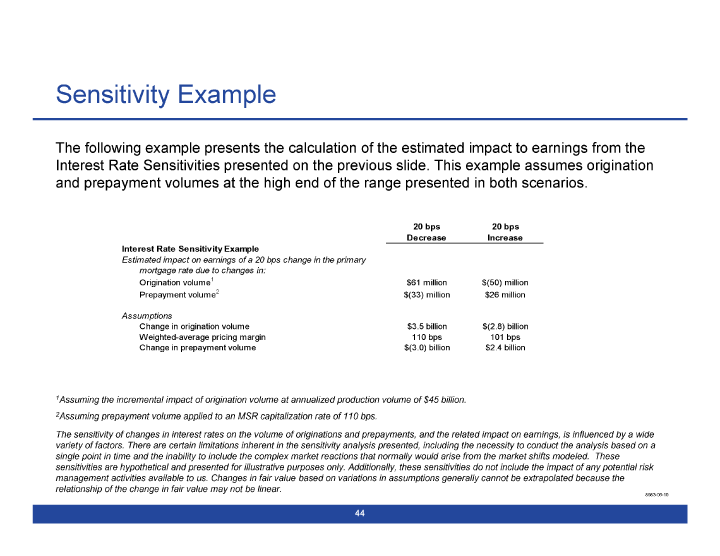
| Sensitivity Example The following example presents the calculation of the estimated impact to earnings from the Interest Rate Sensitivities presented on the previous slide. This example assumes origination and prepayment volumes at the high end of the range presented in both scenarios. 20 bps 20 bps Decrease Increase Interest Rate Sensitivity Example Estimated impact on earnings of a 20 bps change in the primary mortgage rate due to changes in: Origination volume1 $61 million $(50) million Prepayment volume2 $(33) million $26 million Assumptions Change in origination volume $3.5 billion $(2.8) billion Weighted-average pricing margin 110 bps 101 bps Change in prepayment volume $(3.0) billion $2.4 billion 1Assuming the incremental impact of origination volume at annualized production volume of $45 billion. 2Assuming prepayment volume applied to an MSR capitalization rate of 110 bps. The sensitivity of changes in interest rates on the volume of originations and prepayments, and the related impact on earnings, is influenced by a wide variety of factors. There are certain limitations inherent in the sensitivity analysis presented, including the necessity to conduct the analysis based on a single point in time and the inability to include the complex market reactions that normally would arise from the market shifts modeled. These sensitivities are hypothetical and presented for illustrative purposes only. Additionally, these sensitivities do not include the impact of any potential risk management activities available to us. Changes in fair value based on variations in assumptions generally cannot be extrapolated because the relationship of the change in fair value may not be linear. 8983-06-10 44 |
